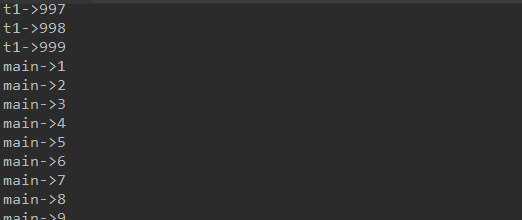# Thread的join方法
关于join官方的解释是 Waits for this thread to die. 也就是等待一个线程结束。
我们来先来一段代码来引入join的使用场景(这里使用了java8的IntStream)
```java
/**
* @program: ThreadDemo
* @description: 正常两个线程交替执行
* @author: hs96.cn@Gmail.com
* @create: 2020-09-03
*/
public class ThreadJoin {
public static void main(String[] args) throws InterruptedException {
Thread t1 = new Thread(() -> {
IntStream.range(1, 1_000).forEach(i ->
System.out.println(Thread.currentThread().getName() + "->" + i)
);
}, "t1");
t1.start();
IntStream.range(1, 1_000).forEach(i ->
System.out.println(Thread.currentThread().getName() + "->" + i)
);
}
}
```
运行结果如下 :

可以看到正常两个线程是交替执行的。如果我们想线程t1执行完再执行main线程呢,这里就需要使用join了:
```java
/**
* @program: ThreadDemo
* @description: 使用join方法线程t1结束后才会执行线程main
* @author: hs96.cn@Gmail.com
* @create: 2020-09-03
*/
public class ThreadJoin {
public static void main(String[] args) throws InterruptedException {
Thread t1 = new Thread(() -> {
//java8 IntStream
IntStream.range(1, 1_000).forEach(i ->
System.out.println(Thread.currentThread().getName() + "->" + i)
);
}, "t1");
t1.start();
t1.join();
IntStream.range(1, 1_000).forEach(i ->
System.out.println(Thread.currentThread().getName() + "->" + i)
);
}
}
```
运行结果如下:

再增加一个子线程,join一下试试:
```java
/**
* @program: ThreadDemo
* @description: 使用join方法线程t1结束后才会执行线程main
* @author: hs96.cn@Gmail.com
* @create: 2020-09-03
*/
public class ThreadJoin {
public static void main(String[] args) throws InterruptedException {
Thread t1 = new Thread(() -> {
//java8 IntStream
IntStream.range(1, 1_000).forEach(i ->
System.out.println(Thread.currentThread().getName() + "->" + i)
);
}, "t1");
Thread t2 = new Thread(() -> {
IntStream.range(1, 1_000).forEach(i ->
System.out.println(Thread.currentThread().getName() + "->" + i)
);
}, "t2");
t1.start();
t2.start();
t1.join();
t2.join();
IntStream.range(1, 1_000).forEach(i ->
System.out.println(Thread.currentThread().getName() + "->" + i)
);
}
}
```


结果和我们的预期一样,两个子线程执行完之后才执行main线程。
join方法还支持几个参数:

一个毫秒级别,一个微妙级别,就是最多等待这个线程执行多久。
代码来测试一下:
```java
/**
* @program: ThreadDemo
* @description: join(long millis), join(long millis, int nanos)
* @author: hs96.cn@Gmail.com
* @create: 2020-09-03
*/
public class ThreadJoin2 {
public static void main(String[] args) throws InterruptedException {
Thread t1 = new Thread(() -> {
try {
System.out.println("t1 is running...");
Thread.sleep(5_000);
System.out.println("t1 is done.");
} catch (InterruptedException e) {
e.printStackTrace();
}
});
t1.start();
//只等待t1线程3秒
t1.join(3_000);
System.out.println("main thread is running...");
}
}
```
运行效果如下:

流程如下:程序开始进入t1线程,开始执行t1线程run方法,t1线程run方法打印t1 is running...,然后开始sleep5秒,这时候程序执行到t1.join(3_000);也就是只等待t1线程3秒,等待结束后main线程打印main thread is running...,再过大约2秒,t1sleep结束,打印t1 is done。后面的我们就不测试了,现在引出一个新的问题:
一些嵌入式的HTTP Server,比如jetty,为什么把任务启动,一会之后会自动挂掉?其实原因很简单就是在主线程退出之后会把http server挂掉(守护线程),避免占用端口、浪费资源。解决办法是使用Thread.currentThread().join();。让当前线程执行,直到当前线程死掉。
测试代码如下:
```java
/**
* @program: ThreadDemo
* @description: join(long millis), join(long millis, int nanos)
* @author: hs96.cn@Gmail.com
* @create: 2020-09-03
*/
public class ThreadJoin2 {
public static void main(String[] args) throws InterruptedException {
Thread.currentThread().join();
}
}
```
运行效果如下:

可以看到currentThread一直在等待,thread done....永远不会输出出来。
接下来结合一个案例感受一下join在多线程中的使用场景:比如我们启动多个线程来采集服务器节点的信息,那么我们该如何保证唯一的采集结束时间呢?
```java
/**
* @program: ThreadDemo
* @description: 采集服务器节点的信息的例子。问题:多个线程如何得到唯一的采集结束时间?
* @author: hs96.cn@Gmail.com
* @create: 2020-09-03
*/
public class ThreadJoin3 {
public static void main(String[] args) throws InterruptedException {
long startTimestamp = System.currentTimeMillis();
// 假设有三台机器,开启三个线程。
Thread m1 = new Thread(new CaptureRunnable("M1", 1_000L));
Thread m2 = new Thread(new CaptureRunnable("M2", 2_000L));
Thread m3 = new Thread(new CaptureRunnable("M3", 3_000L));
m1.start();
m2.start();
m3.start();
long endTimestamp = System.currentTimeMillis();
System.out.printf("Save data begin timestamp is %s, end timestamp is %s\n", startTimestamp, endTimestamp);
System.out.printf("Spend time is %s", endTimestamp - startTimestamp);
}
}
/**
* 采集服务器节点的任务。
*/
class CaptureRunnable implements Runnable {
// 机器节点的名称
private String machineName;
// 采集花费时间
private long spendTime;
public CaptureRunnable(String machineName, long spendTime) {
this.machineName = machineName;
this.spendTime = spendTime;
}
@Override
public void run() {
// do the really capture data.
try {
Thread.sleep(spendTime);
System.out.printf(machineName + " completed data capture at timestamp [%s] and successful.\n", System.currentTimeMillis());
} catch (InterruptedException e) {
e.printStackTrace();
}
}
public String getResult() {
return machineName + " finish.";
}
}
```
运行效果如下:

可以看到三个线程还没走完,就提前把时间打印出来了,这个不是我我们想要的效果,那么我们让三个线程join一下试试:
```java
// 假设有三台机器,开启三个线程。
Thread m1 = new Thread(new CaptureRunnable("M1", 1_000L));
Thread m2 = new Thread(new CaptureRunnable("M2", 2_000L));
Thread m3 = new Thread(new CaptureRunnable("M3", 3_000L));
m1.start();
m2.start();
m3.start();
m1.join();
m2.join();
m3.join();
```
运行效果如下:

这样就达到我们想要的效果了。
- 微服务
- 服务器相关
- 操作系统
- 极客时间操作系统实战笔记
- 01 程序的运行过程:从代码到机器运行
- 02 几行汇编几行C:实现一个最简单的内核
- 03 黑盒之中有什么:内核结构与设计
- Rust
- 入门:Rust开发一个简单的web服务器
- Rust的引用和租借
- 函数与函数指针
- Rust中如何面向对象编程
- 构建单线程web服务器
- 在服务器中增加线程池提高吞吐
- Java
- 并发编程
- 并发基础
- 1.创建并启动线程
- 2.java线程生命周期以及start源码剖析
- 3.采用多线程模拟银行排队叫号
- 4.Runnable接口存在的必要性
- 5.策略模式在Thread和Runnable中的应用分析
- 6.Daemon线程的创建以及使用场景分析
- 7.线程ID,优先级
- 8.Thread的join方法
- 9.Thread中断Interrupt方法学习&采用优雅的方式结束线程生命周期
- 10.编写ThreadService实现暴力结束线程
- 11.线程同步问题以及synchronized的引入
- 12.同步代码块以及同步方法之间的区别和关系
- 13.通过实验分析This锁和Class锁的存在
- 14.多线程死锁分析以及案例介绍
- 15.线程间通信快速入门,使用wait和notify进行线程间的数据通信
- 16.多Product多Consumer之间的通讯导致出现程序假死的原因分析
- 17.使用notifyAll完善多线程下的生产者消费者模型
- 18.wait和sleep的本质区别
- 19.完善数据采集程序
- 20.如何实现一个自己的显式锁Lock
- 21.addShutdownHook给你的程序注入钩子
- 22.如何捕获线程运行期间的异常
- 23.ThreadGroup API介绍
- 24.线程池原理与自定义线程池一
- 25.给线程池增加拒绝策略以及停止方法
- 26.给线程池增加自动扩充,闲时自动回收线程的功能
- JVM
- C&C++
- GDB调试工具笔记
- C&C++基础
- 一个例子理解C语言数据类型的本质
- 字节顺序-大小端模式
- Php
- Php源码阅读笔记
- Swoole相关
- Swoole基础
- php的五种运行模式
- FPM模式的生命周期
- OSI网络七层图片速查
- IP/TCP/UPD/HTTP
- swoole源代码编译安装
- 安全相关
- MySql
- Mysql基础
- 1.事务与锁
- 2.事务隔离级别与IO的关系
- 3.mysql锁机制与结构
- 4.mysql结构与sql执行
- 5.mysql物理文件
- 6.mysql性能问题
- Docker&K8s
- Docker安装java8
- Redis
- 分布式部署相关
- Redis的主从复制
- Redis的哨兵
- redis-Cluster分区方案&应用场景
- redis-Cluster哈希虚拟槽&简单搭建
- redis-Cluster redis-trib.rb 搭建&原理
- redis-Cluster集群的伸缩调优
- 源码阅读笔记
- Mq
- ELK
- ElasticSearch
- Logstash
- Kibana
- 一些好玩的东西
- 一次折腾了几天的大华摄像头调试经历
- 搬砖实用代码
- python读取excel拼接sql
- mysql大批量插入数据四种方法
- composer好用的镜像源
- ab
- 环境搭建与配置
- face_recognition本地调试笔记
- 虚拟机配置静态ip
- Centos7 Init Shell
- 发布自己的Composer包
- git推送一直失败怎么办
- Beyond Compare过期解决办法
- 我的Navicat for Mysql
- 小错误解决办法
- CLoin报错CreateProcess error=216
- mysql error You must reset your password using ALTER USER statement before executing this statement.
- VM无法连接到虚拟机
- Jetbrains相关
- IntelliJ IDEA 笔记
- CLoin的配置与使用
- PhpStormDocker环境下配置Xdebug
- PhpStorm advanced metadata
- PhpStorm PHP_CodeSniffer
